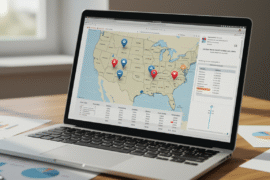This article may contain references to products or services from one or more of our advertisers or partners. We may receive compensation when you click on links to those products or services. Nonetheless, our opinions are our own.
The information presented in this article is accurate to the best of our knowledge at the time of publication. However, information is subject to change, and no guarantees are made about the continued accuracy or completeness of this content after its publication date.
- Introduction
- Understanding the Importance of a Budget
- Identifying Your Income and Expenses
- Setting Realistic Financial Goals
- Creating a Simple Budgeting Plan
- Tracking Your Progress and Adjusting as Necessary
- Strategies for Paying Off Debt Effectively
- Planning for Retirement as Part of Your Budget
- Frequently Asked Questions
- Recommended Reads
Introduction
Welcome to your financial journey: Baby Step 1—Your Budgeting Guide. You may know the saying, “A journey of a thousand miles begins with a single step.” The first step in managing your money is budgeting. It can feel challenging, especially if you do not know where to start or have tried and failed. Many people think the same way. This article will cover the key parts of budgeting to help you take charge of your finances and feel more confident. It will also help you build a strong foundation for your future financial goals. When you see budgeting as a helpful tool instead of a challenging task, you will learn to manage your money to match your values and dreams. Let’s start changing how you feel about money today!
Understanding the Importance of a Budget
Having a budget is not only about numbers. It helps you feel empowered and better understand your finances. When you write down your income and expenses, you get a clearer view of your money. A budget shows where your money is spent, allowing you to spend wisely instead of making random choices. By setting limits, you control how much you spend and can focus on what you need while saving for what you want.
Benefits of Budgeting
- Financial Awareness: You find out where your money goes.
- Goal Setting: A budget helps you set and achieve clear financial goals.
- Reduced Stress: Knowing more about your money can help you feel less worried about finances.
- Accountability: A budget makes you responsible for your financial plans.
To help you start this journey, here is a basic budgeting plan:
| Category | Percentage of Income |
|---|---|
| Housing | 30% |
| Utilities | 10% |
| Groceries | 15% |
| Savings | 20% |
| Discretionary Spending | 15% |
| Debt Repayment | 10% |
This framework is just a starting point. You can adjust the percentages to fit your needs. Remember, a budget is not meant to restrict your spending but to guide you toward financial stability and freedom.
Identifying Your Income and Expenses
To manage your money better, first identify your sources of income. This includes your salary, freelance work, side projects, or other earnings. Write down all the money coming into your household each month:
- Money from a job
- Income from freelance work or consulting
- Earnings from investments
- Rental income
- Other types of income, such as alimony or child support
Next, organize your expenses by splitting them into fixed and variable categories.
| Fixed Expenses | Variable Expenses |
|---|---|
| Rent/Mortgage | Utilities (Electric, Gas, Water) |
| Insurance (Health, Auto, Home) | Groceries |
| Loan Payments (Student, Auto) | Dining Out |
| Subscription Services | Entertainment |
Knowing your income and expenses helps you create a solid budget plan. Understanding your numbers lets you decide where to cut back or allocate more money effectively.
Setting Realistic Financial Goals
Setting realistic goals is essential when working towards financial stability. Break them into smaller, achievable steps instead of focusing only on long-term dreams.
Tips for Setting Financial Goals
- Check Your Income and Expenses: Review your finances to determine realistic targets.
- Choose Your Goals: Prioritize key objectives such as paying off debt, building an emergency fund, or saving for a vacation.
- Set Clear Deadlines: Assign specific timeframes to each goal to stay motivated and track progress.
| Goal | Amount Needed | Timeframe |
|---|---|---|
| Emergency Fund | $1,000 | 6 Months |
| Pay Off Credit Card | $2,500 | 1 Year |
| Vacation Fund | $1,500 | 9 Months |
Setting clear goals and deadlines helps track progress and celebrate small wins.
Voted "Best Overall Budgeting App" by Forbes and WSJ
Monarch Money helps you budget, track spending, set goals, and plan your financial future—all in one app.
Get 50% OFF your first year with code MONARCHVIP
Creating a Simple Budgeting Plan
Creating a budget is straightforward. List your income and expenses to see where your money goes. Then, categorize your expenses into fixed and variable costs.
| Category | Amount |
|---|---|
| Income | $3,500 |
| Fixed Expenses | $1,500 |
| Variable Expenses | $800 |
| Savings | $500 |
| Remaining Balance | $700 |
This structure helps you understand how much you can save or spend while adjusting your budget to focus on essential costs. Consistency is key—review your budget monthly and make changes if necessary.
Tracking Your Progress and Adjusting as Necessary
Regularly reviewing your spending ensures that you stay on track. Monitor your budget weekly or monthly and make adjustments as needed. Budgeting is a flexible tool, not a strict rule.
Strategies for Budget Adjustments
- Use budgeting apps or spreadsheets to track spending.
- Review spending categories to find areas for savings.
- Ensure financial goals align with any lifestyle changes.
| Category | Current Budget | Suggested Adjustments |
|---|---|---|
| Groceries | $300 | $250 |
| Entertainment | $150 | $100 |
| Utilities | $200 | $220 |
Making necessary changes keeps your budget effective and aligned with your financial goals.
Building Healthy Financial Habits for the Future
Tracking income and expenses allows you to create a sustainable budget. A helpful guideline to follow is the 50/30/20 rule:
| Category | Percentage |
|---|---|
| Needs | 50% |
| Wants | 30% |
| Savings and Debt Repayment | 20% |
Adjust these percentages based on your financial needs and goals. Staying flexible and reviewing your budget regularly will ensure that it continues to work for you.
Building Your Starter Emergency Fund
Establishing an emergency fund is a crucial step toward financial stability. Start with a $1,000 emergency fund, then gradually increase it to cover 3-6 months of living expenses.
Strategies for Paying Off Debt Effectively
- Pay off high-interest debts first.
- Consider debt consolidation to simplify payments.
- Use the snowball method—pay off smaller debts first, then roll those payments into more significant debts.
- Track progress and adjust your budget if necessary.
Planning for Retirement as Part of Your Budget
Every step toward managing money contributes to financial security. Consistently saving and investing in retirement accounts can help you include retirement planning in your budget.
Free Resources to Support Your Budgeting Journey
- Use Online Budgeting Tools: Apps like Mint or YNAB help track income, expenses, and savings.
- Seek Expert Advice: Financial counseling services can provide tailored guidance.
- Automate Savings: Set up automatic transfers to savings or retirement accounts to ensure consistent contributions.
Frequently Asked Questions
What is Baby Step 1 in budgeting?
Baby Step 1 focuses on creating a simple budget and saving the first $1,000 for an emergency fund to cover unexpected expenses and avoid debt.
Why is having a budget important?
A budget helps track income and expenses, improving financial awareness and decision-making for long-term stability.
How do I create a budget?
List income sources, essential costs (housing, utilities, food), and discretionary expenses. Adjust spending as needed to stay within budget.
What are some standard budgeting methods?
Popular methods include the zero-based budget, the 50/30/20 rule, and the envelope system for managing spending categories.
How can I stick to my budget?
Monitor spending regularly, adjust when needed, and use budgeting tools or apps for easier tracking.
What should I do if I exceed my budget?
Identify overspending areas, adjust your budget accordingly, and save for unexpected expenses in the future.
How often should I review my budget?
Review your budget at least once a month to ensure it aligns with your financial goals and changing circumstances.
What tools can help with budgeting?
Spreadsheets, budgeting apps like Mint or YNAB, or even manual tracking methods can help you manage your finances.

Reviewed and edited by Albert Fang.
See a typo or want to suggest an edit/revision to the content? Use the contact us form to provide feedback.
At FangWallet, we value editorial integrity and open collaboration in curating quality content for readers to enjoy. Much appreciated for the assist.
Did you like our article and find it insightful? We encourage sharing the article link with family and friends to benefit as well - better yet, sharing on social media. Thank you for the support! 🍉
Article Title: Baby Step 1 Budgeting: The First Move to Financial Freedom
https://fangwallet.com/2025/03/19/baby-step-1-budgeting/The FangWallet Promise
FangWallet is an editorially independent resource - founded on breaking down challenging financial concepts for anyone to understand since 2014. While we adhere to editorial integrity, note that this post may contain references to products from our partners.
The FangWallet promise is always to have your best interest in mind and be transparent and honest about the financial picture.
Become an Insider

Subscribe to get a free daily budget planner printable to help get your money on track!
Make passive money the right way. No spam.
Editorial Disclaimer: The editorial content on this page is not provided by any of the companies mentioned. The opinions expressed here are the author's alone.
The content of this website is for informational purposes only and does not represent investment advice, or an offer or solicitation to buy or sell any security, investment, or product. Investors are encouraged to do their own due diligence, and, if necessary, consult professional advising before making any investment decisions. Investing involves a high degree of risk, and financial losses may occur including the potential loss of principal.
Source Citation References:
+ Inspo
There are no additional citations or references to note for this article at this time.












































